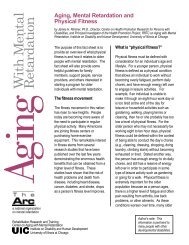Bridging the Aging and Developmental Disabilities Service ... - rrtcadd
Bridging the Aging and Developmental Disabilities Service ... - rrtcadd
Bridging the Aging and Developmental Disabilities Service ... - rrtcadd
You also want an ePaper? Increase the reach of your titles
YUMPU automatically turns print PDFs into web optimized ePapers that Google loves.
• State funding authorized by <strong>the</strong> state legislature plus <strong>the</strong> availability of local funding<br />
resources.<br />
• The optional services states include in <strong>the</strong>ir Medicaid state plan.<br />
• States’ use of <strong>the</strong> 1915 (c) Medicaid waiver to fund home <strong>and</strong> community-based services.<br />
• Whe<strong>the</strong>r states use a fee-for-service or a managed care model of service delivery.<br />
The <strong>Aging</strong> <strong>Service</strong> System<br />
The Older Americans Act (OAA) of 1965 (P.L. 89-73) was legislated to maximize <strong>the</strong><br />
independence of older people <strong>and</strong> help vulnerable older adults remain in <strong>the</strong>ir home <strong>and</strong><br />
community by providing a limited array of services to support <strong>the</strong>se outcomes. The OAA <strong>and</strong> its<br />
amendments established a national infrastructure consisting of <strong>the</strong> Administration on <strong>Aging</strong><br />
(AoA) <strong>and</strong> <strong>the</strong> national network of state units on aging, area agencies on aging, tribal <strong>and</strong> Native<br />
American organizations, <strong>and</strong> community agencies to plan <strong>and</strong> deliver its services, <strong>and</strong> to<br />
advocate progressive public policies <strong>and</strong> programs. The AoA within <strong>the</strong> Department of Health<br />
<strong>and</strong> Human <strong>Service</strong>s administers OAA programs <strong>and</strong> services <strong>and</strong> is <strong>the</strong> federal focal point for<br />
addressing issues affecting older persons. OAA services are targeted to older adults with <strong>the</strong><br />
greatest social <strong>and</strong> economic need <strong>and</strong> who are at risk of institutionalization. States <strong>and</strong> Area<br />
Agencies on <strong>Aging</strong> (AAAs) use OAA funds to leverage o<strong>the</strong>r funding sources. Key components<br />
of <strong>the</strong> OAA include:<br />
• Title III provides nutrition programs, supportive services (e.g., information <strong>and</strong> access,<br />
home care, adult day services, case management, <strong>and</strong> senior center activities), <strong>the</strong><br />
National Family Caregiver Support Program, <strong>and</strong> disease prevention <strong>and</strong> health<br />
promotion programs. Title III services are entitlements that are available to all people age<br />
60 <strong>and</strong> older (with some exceptions) at no cost, although participants are encouraged to<br />
make voluntary contributions to specific programs (such as congregate meals). Nearly<br />
two-thirds of <strong>the</strong> OAA budget is allocated to Title III services.<br />
• Title IV funds research, training, demonstration <strong>and</strong> technical assistance projects to<br />
improve aging services.<br />
• Title V funds <strong>the</strong> Community <strong>Service</strong> Employment Program which provides job training<br />
<strong>and</strong> employment for low income older people.<br />
• Title VII funds <strong>the</strong> Long-Term Care Ombudsman <strong>and</strong> Elder Abuse programs.<br />
The OAA was last reauthorized in 2006 <strong>and</strong> <strong>the</strong> scheduled reauthorization in 2011 did not occur.<br />
The various amendments since 1986 have contained provisions for support services to older<br />
families caring for adult children with disabilities <strong>and</strong> for state plans to coordinate services for<br />
18, 19, 20<br />
older adults with severe disabilities which include developmental disabilities.<br />
<strong>Bridging</strong> <strong>the</strong> <strong>Aging</strong> <strong>and</strong> <strong>Developmental</strong> <strong>Disabilities</strong> <strong>Service</strong> Networks Page 16



